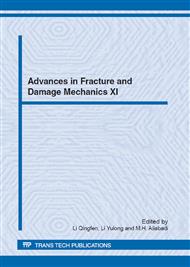p.453
p.457
p.461
p.465
p.469
p.473
p.477
p.481
p.485
Characterization of Ductile Failure Behavior of the Ferritic Steel Using Damage Mechanics Modeling Approach
Abstract:
A ductile failure is characterized by pronounced plastic deformations which involve significant plastic strains. The modeling of this failure behavior requires a precise description of the material plasticity starting from the crack initiation, its propagation through the material to the final fracture. The classical theory of metal plasticity based on the von Mises or Tresca formulations assumes that the effect of hydrostatic pressure on the flow potential is insignificant. Furthermore, it postulates that the flow stress is independent of the third stress invariant of the deviatoric stress tensor. The scientific findings from last few years show, however, that these both quantities should be considered for the precise description of plasticity, especially, of the real materials [1-4].
Info:
Periodical:
Pages:
469-472
Citation:
Online since:
November 2012
Authors:
Price:
Сopyright:
© 2013 Trans Tech Publications Ltd. All Rights Reserved
Share:
Citation:


